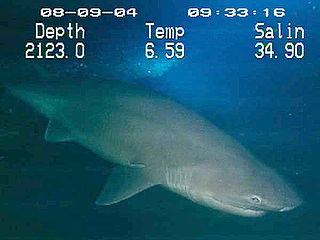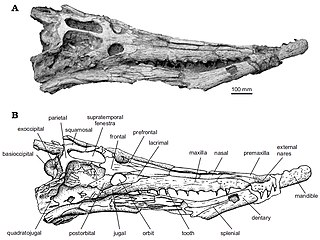
Otodus megalodon, commonly known as the megalodon, is an extinct species of giant mackerel shark that lived approximately 23 to 3.6 million years ago (Mya), from the Early Miocene to the Pliocene epochs. It was formerly thought to be a member of the family Lamnidae and a close relative of the great white shark, but has been reclassified into the extinct family Otodontidae, which diverged from the great white shark during the Early Cretaceous.

Cow sharks are a shark family, the Hexanchidae, characterized by an additional pair or pairs of gill slits. Its 37 species are placed within the 10 genera: Gladioserratus, Heptranchias, Hexanchus, Notidanodon, Notorynchus, Pachyhexanchus, Paraheptranchias, Pseudonotidanus, Welcommia, and Weltonia.

Squalicorax, commonly known as the crow shark, is a genus of extinct lamniform shark known to have lived during the Cretaceous period. The genus had a global distribution in the Late Cretaceous epoch. Multiple species within this genus are considered to be wastebasket taxon due to morphological similarities in the teeth.

Cretoxyrhina is an extinct genus of large mackerel shark that lived about 107 to 73 million years ago during the late Albian to late Campanian of the Late Cretaceous. The type species, C. mantelli, is more commonly referred to as the Ginsu shark, first popularized in reference to the Ginsu knife, as its theoretical feeding mechanism is often compared with the "slicing and dicing" when one uses the knife. Cretoxyrhina is traditionally classified as the likely sole member of the family Cretoxyrhinidae but other taxonomic placements have been proposed, such as within the Alopiidae and Lamnidae.

Sclerorhynchus is an extinct genus of ganopristid sclerorhynchoid that lived during the Late Cretaceous. The genus Ganopristis is considered a junior synonym of Sclerorhynchus. It was a widespread genus, with fossils found in the Middle East, North Africa, Europe, and North America. While it had a long rostrum with large denticles similar to sawfishes and sawsharks, its closest living relatives are actually skates. Complete specimens of S. atavus show that its fin arrangement was similar to skates, with the pectoral and pelvic fins touching, both dorsal fins located behind the pelvic fins, and a reduced caudal fin.

Carcharias is a genus of mackerel sharks belonging to the family Odontaspididae. Once bearing many prehistoric species, all have gone extinct with the exception of the critically endangered sand tiger shark.

Arambourgisuchus is an extinct genus of dyrosaurid crocodylomorph from the late Palaeocene of Morocco, found in the region of Sidi Chenane in 2000, following collaboration by French and Moroccan institutions, and described in 2005 by a team led by palaeontologist Stéphane Jouve. Arambourgisuchus was a large animal with an elongated skull 1 meter in length.
Congosaurus is an extinct genus of dyrosaurid mesoeucrocodylian. Fossils have been found from Lândana, in Angola and date back to the Paleocene epoch. In 1952 and 1964 Congosaurus was proposed to be synonymous with Dyrosaurus. The genus was later thought synonymous with Hyposaurus in 1976 and 1980. It has since been proven a distinct genus of dyrosaurid separate from both Dyrosaurus and Hyposaurus.
Brouweria is an extinct genus of prehistoric ray-finned fish. It was named by L.F. de Beaufort (1926) and assigned the family Elopsidae. It was discovered by Professor H.A. Brouwer after rock had been exploded to construct a road, from Miocene rocks near Putanuang Asu E.

Cardabiodon is an extinct genus of large mackerel shark that lived about 95 to 91 million years ago (Ma) during the Cenomanian to Turonian of the Late Cretaceous. It is a member of the Cardabiodontidae, a family unique among mackerel sharks due to differing dental structures, and contains the two species C. ricki and C. venator. Cardabiodon fossils have been found in Australia, North America, England, and Kazakhstan. It was likely an antitropical shark that inhabited temperate neritic and offshore oceans between 40° and 60° paleolatitude, similar to the modern porbeagle shark.

Fodonyx is an extinct genus of rhynchosaur from the middle Triassic epoch of Devon in England. Its fossils were discovered in Otter Sandstone Formation and were first assigned to Rhynchosaurus spenceri. This species was reassigned to its own genus, Fodonyx the holotype of which is EXEMS 60/1985/292, that described by David W. E. Hone and Michael J. Benton in 2008. More recently, one skull was reassigned to the new genus Bentonyx. It is distinguished from other rhynchosaurs by a single autapomorphy, the ventral angling of the paraoccipital processes. In all other rhynchosaurs these processes angle dorsally or are horizontal. It is not known if this conferred any advantage to Fodonyx. Fodonyx was between 40 and 50 cm long.
Dianopachysaurus is an extinct genus of pachypleurosaur known from the lower Middle Triassic of Yunnan Province, southwestern China. It was found in the Middle Triassic Lagerstatte of the Guanling Formation. It was first named by Jun Liu, Olivier Rieppel, Da-Yong Jiang, Jonathan C. Aitchison, Ryosuke Motani, Qi-Yue Zhang, Chang-Yong Zhou and Yuan-Yuan Sun in 2011 and the type species is Dianopachysaurus dingi, thanking a Professor Ding for his help.

Otodus auriculatus is an extinct species of large sharks in the genus Otodus of the family Otodontidae, closely related to the sharks of the genus Otodus, and also closely related to the later species megalodon. The largest individuals were about 9.5 metres (31 ft) long. Its teeth were large, having coarse serrations on the cutting edge, and also with two large cusplets. The teeth can reach up to 130 millimetres (5.1 in), and belonged to a large "megatoothed" shark.

Cretalamna is a genus of extinct otodontid shark that lived from the latest Early Cretaceous to Eocene epoch. It is considered by many to be the ancestor of the largest sharks to have ever lived, such as Otodus angustidens, Otodus chubutensis, and Otodus megalodon.
Huaridelphis is an extinct genus of river dolphins from the Early Miocene. The type species is H. raimondii, found in the Chilcatay Formation of the Pisco Basin.

Onchosaurus is an extinct genus of sclerorhynchid sawskate from the Late Cretaceous. Its fossils have been found in the Cretaceous sediments of Egypt, Brazil, Congo, Morocco, France, Niger, Japan, Chile, Peru and the United States.

Cosmopolitodus is an extinct genus of mackerel shark that lived between thirty and one million years ago during the late Oligocene to the Early Pleistocene epochs. Its type species is Cosmopolitodus hastalis, the broad-tooth mako. In 2021, Isurus planus was reassigned to the genus, and thus became the second species C. planus.
Heptranchias howelli, the sevengill shark, is a nektonic carnivore in the genus Heptranchias. It is an extinct species that ranged from 37.2 to 20.43 Ma.

Megaceroides algericus is an extinct species of deer known from the Late Pleistocene to the Holocene of North Africa. It is one of only two species of deer known to have been native to the African continent, alongside the Barbary stag, a subspecies of red deer. It is considered to be closely related to the giant deer species of Eurasia.
Ganopristidae is an extinct family of cartilaginous fish from the Cretaceous belonging to the suborder Sclerorhynchoidei. While the name Sclerorhynchidae is often used for this family, it is a junior synonym of Ganopristidae. This family contains the genera Libanopristis, Micropristis, and Sclerorhynchus. The type genus Ganopristis is considered to be a junior synonym of Sclerorhynchus.














